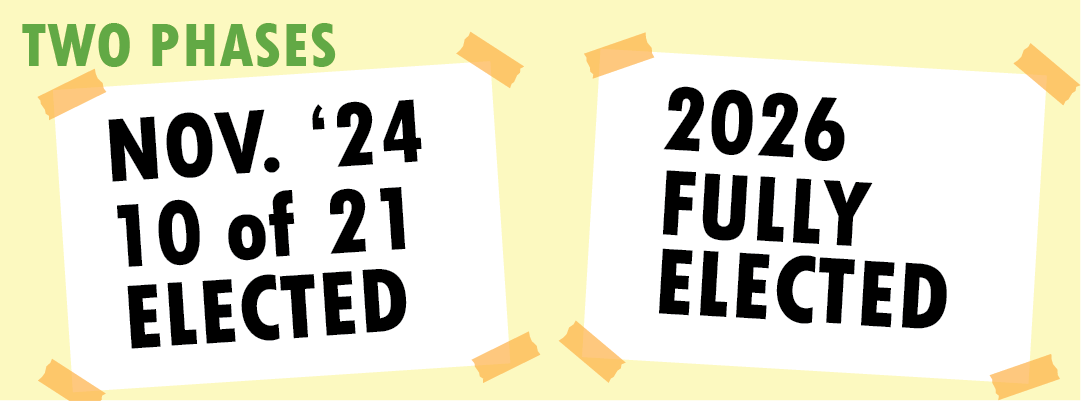Beyond The Ballot: Vote For Chicago’s First Elected School Board!

This November, Chicago will hold elections for the Chicago Board of Education (CBE) for the first time. Based on a law passed in 2021, the Chicago Board of Education will transition from a seven-member board appointed by the mayor to a 21-member elected board. This will eventually make the CBE the largest school board in any major city. The CBE oversees Chicago Public Schools (CPS), a large public school system that educates an average of 325,000 students annually. Deciding who sits on school boards is one of the most important decisions we make as voters!
History of Chicago School Board Elections
The upcoming transition to a fully elected CBE is part of years-long attempts to see reforms to the board. Since the 1870s, the selection of CBE positions rested in the hands of the mayor. In 1988, CPS experienced what is still the longest strike in its history, lasting nearly three weeks. During this strike, there were calls to reform the CBE, including the potential to directly elect CBE members to increase community input. In response, the Illinois General Assembly passed the Chicago School Reform Act. This Act created local school councils (LSCs) for each CPS school composed of teachers, parents, community members, and a student representative at the high school level. These councils were responsible for issues like hiring and evaluating principals and approving the school site budget. The Act also created a School Board Nominating Commission consisting of 23 parents, community members, and five members appointed by the Mayor of Chicago who would recommend nominees for all the CBE seats to the mayor. The results of these new reforms were mixed. Some schools thrived under this new local council system, while others struggled due to dysfunction or a lack of expertise on how to manage schools. While the LSCs would stay in place, due to the inconsistent results of the Chicago School Reform Act, in 1995 the power to appoint members to the Chicago school board was put solely back in the hands of the mayor. Giving the ability to appoint members of the CBE back to the mayor would only increase calls for a fully elected school board.
The decades-long call by advocates for an elected CBE is rooted in the belief that there must be more accountability of the CBE to the public through regular elections. Pro-CBE election advocates point to the closure of multiple schools on the city’s South and West sides, which disproportionately affect Black and Latinx low-income families. There is also a large concern over the lack of transparency. Advocates state that mayor-appointed CBEs give special-interest groups with large funding the upper hand in influencing local politics. There has been an expansion of privately-run, non-union charter schools that advocates point to as a major priority of Chicago’s board over the years. Both former Mayors Richard M. Daley and Rahm Emanuel were avid proponents of privatizing education and replacing regular public schools with non-unionized charter schools and people believe their CBEs reflected the push in that direction. Advocates state that not allowing parents of CPS students and community members the ability to elect CBE members greatly limits the ability of CBEs to meet the needs of minority CPS students. While advocates do point to the more diverse CBE appointments by former mayor Lori Lightfoot and current mayor Brandon Johnson, they feel elections will allow the majority of CPS students, who are 47% Latinx and 35% Black compared to 11% white, to have a greater voice and access to resources.
How will the new school board elections work?

The move towards a fully elected school board will happen in a couple of phases. This November, voters will elect 10 of the new 21-member board while the other 11 seats will be appointed by the mayor. The CBE school board will spend the next two years as a half-elected, half-appointed school board. In 2026 voters will elect the full number of school board seats. For this November’s election, Illinois lawmakers divided Chicago into 10 districts. On Nov. 5, residents of each district will elect a school board member to represent them for two years. On or before Dec. 16, 2024, Mayor Brandon Johnson will appoint 10 school board members — one from each district — and a board president to serve two-year terms. For example, District 1 is made up of two parts: 1A and a 1B. If the winning candidate in District 1 lives in 1A, the mayor must appoint someone who lives in 1B. If the winner in District 2 lives in 2B, the mayor must appoint someone who lives in 2A, and so on. The districts have been drawn with the intention that anyone running in that district is reflective and knowledgeable of the demographics and needs of students in those districts.
The Chicago school board votes on the district’s annual multi-billion dollar budget determines the metrics for how well schools are performing, authorizes contracts with vendors to bus students to and from school, clean classrooms and hallways, and even operates entire schools under charter agreements. This is an opportunity for Chicagoans to be involved in supporting the needs of CPS students. You can visit the Chicago Board of Elections to learn more about the school board elections and to see a list of candidates. You can read furtherabout school boards to better understand how school boards are at the forefront of providing or eliminating inclusive and equitable environments and the effect on LGBTQ+ students.
To learn more about how Howard Brown Health contributes to vital advocacy work and has an impact on local, state, and federal policymaking, please visit our Advocacy webpage.